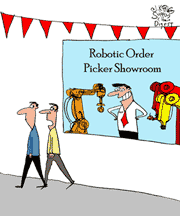In Supply Chain It Pays to Put it in Writing
Once a year or so, SCDigest editor Dan Gilmore gives up his weekly First Thoughts perch to an outside guest as part of his taking a vacation, usually on a beach somewhere with his family.
Once again this year, David Schneider, president of consulting firm David K. Schneider & Associates and former logistics executive at auto parts retailer Pep Boys, takes over the reigns, with message this time around about the important of putting most everything in writing.
| GILMORE SAYS: |
The effort to fix the mess always takes more time than the effort to write the instructions.
WHAT DO YOU SAY?
Send us your
Feedback here
|
His guest column starts here:
This story is about a small contract on a small project with a huge lesson about why you should always put instructions and expectations in writing.
The client project was small, setting up 1,100 square feet of warehouse to support a small ecommerce company. The walls needed cleaning and painting. I was breaking in a new associate, teaching them how to manage bidding and contract execution. My assistant looked up commercial painting contractors, made the calls, and got bids for the work. She reviewed the bids and made a recommendation in a written memo outlining the reasons behind the recommendation.
She recommended a specific contractor because they gave a formal written proposal, and in meetings with the estimator at the site, the estimator clearly understood the project. The bid was the middle bid, and was well within the budget that we established the work. The client approved the recommendation, signed the proposal, and made the deposit.
All was good until the project supervisor came to the job site to look over the project. He met with my assistant and, after reviewing the scope of work, said that the pricing on the project was wrong. They contractor needed to rent scaffolds and an unpainted concrete wall was out of scope; the contractor needed an additional $550 to do the work. When my assistant said that the company estimator had seen the space before quoting, the supervisor dismissed the comment by saying "she is new and still in training."
After, my assistant told me that the contractor was jacking the project by an additional $550 over the written proposal. I asked to see the proposal, and saw the problem right away, the proposal did not contain a scope of work. Yes, we had a written proposal, but nothing in writing that indicated the exact scope of work.
 This was a problem. I coached my assistant to call the contractor's office to talk to the estimator, and then the general manager. The supervisor called again and insisted on the additional money. My assistant pressed back in that conversation that the estimator had seen the space and knew the conditions. We had three options; tell the client to vacate the proposal and hire another contractor, get the contractor to eat the additional costs, or we pay to make up the difference in cost. This was a problem. I coached my assistant to call the contractor's office to talk to the estimator, and then the general manager. The supervisor called again and insisted on the additional money. My assistant pressed back in that conversation that the estimator had seen the space and knew the conditions. We had three options; tell the client to vacate the proposal and hire another contractor, get the contractor to eat the additional costs, or we pay to make up the difference in cost.
I saw the proposal before we sent it to the client, so I knew the scope of work was missing and knew we would face a problem with the project. I also knew that the situation was a great teaching tool for my young assistant, so I was willing to take the risk, willing to cover the additional cost between the proposal and the actual cost, because the priceless value of the on-going lesson.
In the end, the contractor agreed to the verbally defined scope of work at the proposed cost. The finished work was acceptable. You may think that this was a win-lose deal. I don't. It is a win-win if all of the parties burn the lesson into their memories and put it into practice. In the end, the project worked out for the client, they got a great value for the work. My new assistant learned a valuable lesson and we did not have to shell out the $550. The contractor may have lost money, but they have the opportunity to teach their estimator an internal lesson.
Repeat after me: All proposals (and staff assignments) must have, in writing, a clear, concise and complete scope of work that describes the process, methods and materials used to complete the work. If the proposal (or assignment) fails to include the written scope of work, it is subject to the whims of interpretation, and is not any better than a handshake deal.
Going into this project, I knew that my assistant would make mistakes. By design, I did not step in and "teach" her how to avoid these mistakes. Why? Because, in my opinion, the best learning comes from mistakes, you learn the why behind the process and methods. If somebody teaches you a working process and method, and it works when you put it into practice, what do you learn?
It worked, and you know that the process and method worked, but you don't learn why it worked.
We supply chain managers know to get much of our deals in writing. We work with the legal teams of our organizations to develop contract that define all sorts of legal terms and conditions, venue, liability, indemnification, termination, payments, confidentiality, recourse and remuneration. Sure, all of these items are important, to the legal team, accounting and finance. But, without the scope of work, the contracts are worthless.
Look at the contracts on your desk now or that you executed in the past month. How much paper space does the legal requirements use, and how much the scope of the actual work?
If you are a smart manager working with smart providers, the scope of work is in its own agreement, a Service Level Agreement (SLA). If you are really smart, the SLA is larger than the master contract. However, not all agreements need a SLA.
Depending on the nature of the work, the scope can be simple enough to take only one paragraph. In fact, a well-written scope of work often is a single sentence.
Take the proposal in my story as an example. I could write the scope like this:
"Clean, prime and paint, with roller, two coats all of interior walls and trim of the warehouse space, from floor to deck of roof, protecting the floor and any objects in the space from splatter or damage."
37 words creating a simple, clear and complete scope of work. My assistant could have avoided about two hours of extra work on her part, and time on the contractor's side, with this simple sentence.
Providence of Practice
Winston Churchill learned a serious lesson in the First World War when he did not put instructions in writing. The project was the Dardanelles campaign, followed by the Gallipoli invasion. Strategically this was a high-risk venture. Both proved to be stunning losses because of execution and leadership failures to follow instructions, leading to Churchill losing his position as First Lord of the Admiralty.
As British Prime Minister in the Second World War, according to Martin Gilbert's excellent book about Churchill's war leadership, Churchill decided that every instruction, suggestion, proposal or criticism from him were to be in writing. Churchill insisted that all answers were to be in writing. Yes, there could be discussion, but decisions, instructions, proposals and criticism in writing.
Driving the Practice Home
As a manager, how often to you give your direct reports instructions verbally and later learn that they did not understand what you told them to do?
As part of my coaching practice, I coach managers to put instructions in writing. Many complain that it takes too long or too much effort to put instructions in writing. When faced with these objections, I smile, and wait for the FUBAR (do a search) to happen, because the FUBAR always happens. I observe the manager take time to straighten out the mess, and the extra effort the rest of the team goes through.
Then I ask three simple questions.
1. How much time did it take to clear up the mess?
2. Would we have avoided the mess if the instructions were in writing?
3. How much time would it have taken to put the instructions in writing?
The effort to fix the mess always takes more time than the effort to write the instructions. The instructions always avoids the mess, because most of the time, the problem was not that the subordinate got something wrong, but the manager missed a critical step.
Any reaction to Schneider's call to "put it in writing?" Have you had any similar experiences with vendors or employees? Let us know your thoughts at the Feedback section below.
|




![]()
![]()
![]()
![]()








 This was a problem. I coached my assistant to call the contractor's office to talk to the estimator, and then the general manager. The supervisor called again and insisted on the additional money. My assistant pressed back in that conversation that the estimator had seen the space and knew the conditions. We had three options; tell the client to vacate the proposal and hire another contractor, get the contractor to eat the additional costs, or we pay to make up the difference in cost.
This was a problem. I coached my assistant to call the contractor's office to talk to the estimator, and then the general manager. The supervisor called again and insisted on the additional money. My assistant pressed back in that conversation that the estimator had seen the space and knew the conditions. We had three options; tell the client to vacate the proposal and hire another contractor, get the contractor to eat the additional costs, or we pay to make up the difference in cost. 

